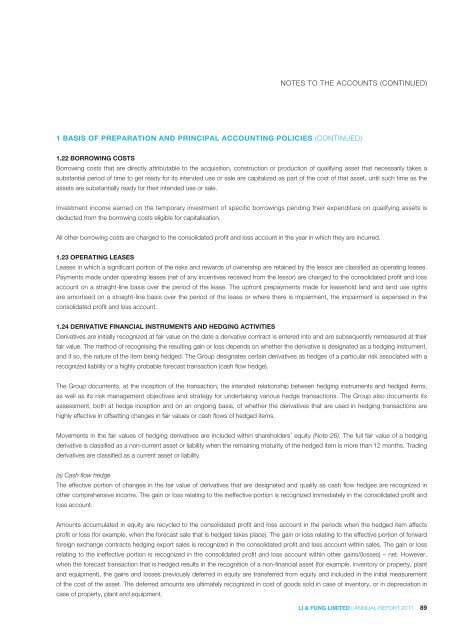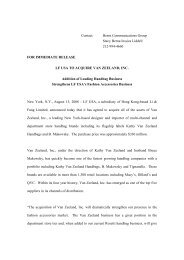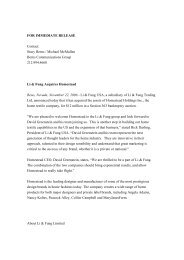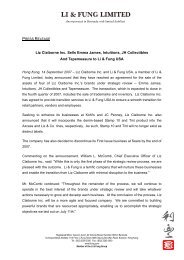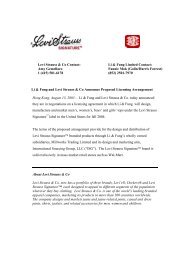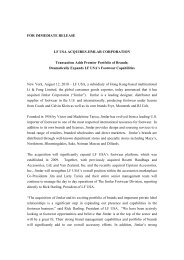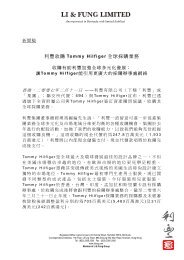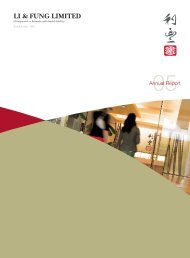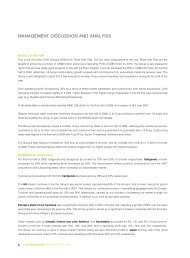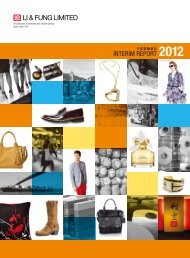2011 - Li & Fung Limited
2011 - Li & Fung Limited
2011 - Li & Fung Limited
- TAGS
- fung
- limited
- www.lifung.com
You also want an ePaper? Increase the reach of your titles
YUMPU automatically turns print PDFs into web optimized ePapers that Google loves.
NOTES TO THE ACCOUNTS (CONTINUED)<br />
1 BASIS OF PREPARATION AND PRINCIPAL ACCOUNTING POLICIES (CONTINUED)<br />
1.22 BORROWING COSTS<br />
Borrowing costs that are directly attributable to the acquisition, construction or production of qualifying asset that necessarily takes a<br />
substantial period of time to get ready for its intended use or sale are capitalized as part of the cost of that asset, until such time as the<br />
assets are substantially ready for their intended use or sale.<br />
Investment income earned on the temporary investment of specific borrowings pending their expenditure on qualifying assets is<br />
deducted from the borrowing costs eligible for capitalisation.<br />
All other borrowing costs are charged to the consolidated profit and loss account in the year in which they are incurred.<br />
1.23 OPERATING LEASES<br />
Leases in which a significant portion of the risks and rewards of ownership are retained by the lessor are classified as operating leases.<br />
Payments made under operating leases (net of any incentives received from the lessor) are charged to the consolidated profit and loss<br />
account on a straight-line basis over the period of the lease. The upfront prepayments made for leasehold land and land use rights<br />
are amortised on a straight-line basis over the period of the lease or where there is impairment, the impairment is expensed in the<br />
consolidated profit and loss account.<br />
1.24 DERIVATIVE FINANCIAL INSTRUMENTS AND HEDGING ACTIVITIES<br />
Derivatives are initially recognized at fair value on the date a derivative contract is entered into and are subsequently remeasured at their<br />
fair value. The method of recognising the resulting gain or loss depends on whether the derivative is designated as a hedging instrument,<br />
and if so, the nature of the item being hedged. The Group designates certain derivatives as hedges of a particular risk associated with a<br />
recognized liability or a highly probable forecast transaction (cash flow hedge).<br />
The Group documents, at the inception of the transaction, the intended relationship between hedging instruments and hedged items,<br />
as well as its risk management objectives and strategy for undertaking various hedge transactions. The Group also documents its<br />
assessment, both at hedge inception and on an ongoing basis, of whether the derivatives that are used in hedging transactions are<br />
highly effective in offsetting changes in fair values or cash flows of hedged items.<br />
Movements in the fair values of hedging derivatives are included within shareholders’ equity (Note 26). The full fair value of a hedging<br />
derivative is classified as a non-current asset or liability when the remaining maturity of the hedged item is more than 12 months. Trading<br />
derivatives are classified as a current asset or liability.<br />
(a) Cash flow hedge<br />
The effective portion of changes in the fair value of derivatives that are designated and qualify as cash flow hedges are recognized in<br />
other comprehensive income. The gain or loss relating to the ineffective portion is recognized immediately in the consolidated profit and<br />
loss account.<br />
Amounts accumulated in equity are recycled to the consolidated profit and loss account in the periods when the hedged item affects<br />
profit or loss (for example, when the forecast sale that is hedged takes place). The gain or loss relating to the effective portion of forward<br />
foreign exchange contracts hedging export sales is recognized in the consolidated profit and loss account within sales. The gain or loss<br />
relating to the ineffective portion is recognized in the consolidated profit and loss account within other gains/(losses) – net. However,<br />
when the forecast transaction that is hedged results in the recognition of a non-financial asset (for example, inventory or property, plant<br />
and equipment), the gains and losses previously deferred in equity are transferred from equity and included in the initial measurement<br />
of the cost of the asset. The deferred amounts are ultimately recognized in cost of goods sold in case of inventory, or in depreciation in<br />
case of property, plant and equipment.<br />
LI & FUNG LIMITED | ANNUAL REPORT <strong>2011</strong><br />
89


